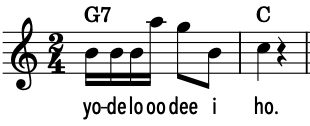Lesson 9
In this lesson, we are going to dive into one of the most iconic yodel songs there is. The Swiss folk song, "Mi Vatter isch en Appezeller" has been recorded and performed by every yodeler specializing in the alpine style of yodeling. The best known version of this song was recorded by Franzl Lang in Bavarian dialect as "Mei Vater is an Appenzeller".
A little research uncovered this interesting notebook page from Felix Mendelssohn-Bartholdy, 1809-1847. The page is dated August 21, 1842 and signed by Mendelsohn. In his letters he mentions being in Appenzell, where it appears he heard a local folk song and wrote the melody and words out. He also included a lovely sketch of the Appenzell valley. You can find characteristics of the song we know today in his transcription.
A little research uncovered this interesting notebook page from Felix Mendelssohn-Bartholdy, 1809-1847. The page is dated August 21, 1842 and signed by Mendelsohn. In his letters he mentions being in Appenzell, where it appears he heard a local folk song and wrote the melody and words out. He also included a lovely sketch of the Appenzell valley. You can find characteristics of the song we know today in his transcription.
The yodel song has three distinct parts with the B and C sections being yodeling only.
|
Translation
My father is from the Appenzell He eats the cheese along with the plate My brother is a really good guy he takes whatever he sees My sister is a noble woman She has seven but is not married But really healthy you know. |
Franzl Lang
Bavarian Lyrics 1956 Mei Vatter is a Appenzeller Er frisst an Kas mitsamt am Deller Mei Bruada is a brava Ma Der nimmt glei mid, ja, wos er ka Mei Schwester is a noble Dam Hod siebn Kinder aber no koan Ma Aber sunst samma recht gsund, woasd! |
Oesch's die Dritten
Swiss Lyrics Mi Vatter isch en Appezeller er frisst den Kas mitsamt dem Teller Mi Vatter isch a braver Ma das seaht ma sina Buaba a Mi Vatter isch a flotter Ma I bi so froh, dass i nea ha |
REINFORCING PAST LEARNING
Review Lesson 3 descending falsetto notes
Review Lesson 5 for sixteenth repeating notes
Review Lesson 7 for descending sixteenth notes
LEARNING OUTCOMES:
You will increase your comfort with longer more complex yodels
You will gain confidence with faster yodeling
You will add a "Bravour" yodel to your song list
Review Lesson 3 descending falsetto notes
Review Lesson 5 for sixteenth repeating notes
Review Lesson 7 for descending sixteenth notes
LEARNING OUTCOMES:
You will increase your comfort with longer more complex yodels
You will gain confidence with faster yodeling
You will add a "Bravour" yodel to your song list
Review these figures from Lesson 5
We are calling this the A section of the song, but within it there are two distinct parts. The first is the singing combined with spectacular yodeling. I have included English lyrics as well.
From Lesson 5, these first two phrases should be very familiar. If you need to, review Lesson 5 then practice these. The practice tempo is 20% slower than the final tempo for these initial sections.
From Lesson 5, these first two phrases should be very familiar. If you need to, review Lesson 5 then practice these. The practice tempo is 20% slower than the final tempo for these initial sections.
English Lyric: My father is an Appenzeller
He eats his cheese and the whole plate too.
The second half of the verse, and for that matter the rest of the song, is a "Bravour" yodel. The word Bravour in German literally means brave or daring. Don't let that scare you. You have been working hard and are ready to braveup.
I start this section with "wee" with a slight scoop to the C. If you need to, take a quick breath after the C in the second measure. Work toward not breathing until the end of the fourth measure.
I start this section with "wee" with a slight scoop to the C. If you need to, take a quick breath after the C in the second measure. Work toward not breathing until the end of the fourth measure.
This yodel should flow like riding a bike up and down hills. Your voice should naturally break from the E in the first measure up to the C and from the D to the B in the third measure.
Similar to the yodel in "Teach Me How To Yodel" Lesson 7, we are seemingly defying gravity here. You may have difficulty with the high note in the figure. If it is too high try the E for a C chord or F for a G7 chord. The faster the music is the harder it is to hear that high note.

yodelcourse by Norm Gwaltney is licensed under a Creative Commons Attribution-NonCommercial-ShareAlike 4.0 International License.














